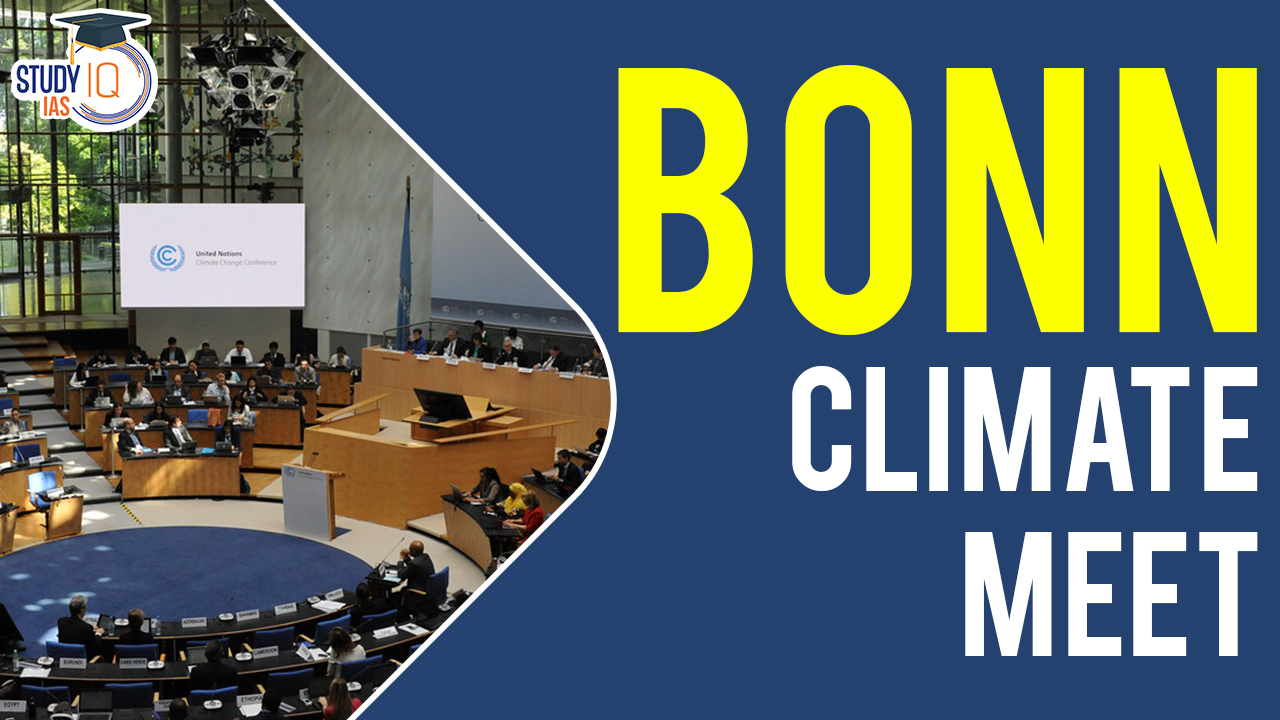Table of Contents
Context: Delegates participating in the Paris Agreement convened in Bonn, Germany, where they made significant progress towards important decisions that will shape the upcoming UN Climate Conference (COP 28) in Dubai in 2023.
More on the News
- With current global efforts to keep rising temperatures in check abysmally inadequate, a massive and immediate scale-up in climate action is essential to keep alive any realistic chance of meeting the 1.5 degree or 2 degree Celsius targets.
- Bonn is expected to act as the springboard for accelerated action.
- At the conclusion of the Bonn session, an agreement was reached to exchange “informal notes,” which will serve as a valuable framework for ongoing efforts in preparation for COP 28.
- These notes will guide further discussions and actions aimed at addressing climate change effectively.
What is Conference of Parties?
- The Conference of the Parties (COP) is the highest decision-making body of the United Nations Framework Convention on Climate Change (UNFCCC).
- It brings together representatives from nearly all countries that are parties to the convention.
- The COP serves as a platform for countries to negotiate and collaborate on global climate policies and actions.
- The COP meets annually, unless the Parties decide otherwise, to review the implementation of the UNFCCC and make decisions on various climate-related issues. These meetings provide an opportunity for countries to assess progress, exchange information and experiences, and negotiate agreements to address climate change.
- The first COP meeting took place in Berlin, Germany, in March 1995, and subsequent meetings have been held in different locations around the world.
- The presidency of the COP rotates among the five regional groups of the United Nations: Africa, Asia, Latin America and the Caribbean, Central and Eastern Europe, and Western Europe and Others.
- The COP President, who is usually the environment minister of their home country, is elected by acclamation at the opening of each COP session.
- The COP plays a crucial role in shaping international climate policies, setting targets, establishing guidelines for reporting and verification, mobilizing financial resources, and facilitating cooperation among countries to address climate change.
Key Takeaway from the Bonn Climate Meeting
- Global Stocktake (GST):
- The technical discussions on the global stocktake, mandated by the 2015 Paris Agreement, were concluded.
- The stocktake is an assessment of progress in the fight against climate change and aims to enhance global action.
- A framework was developed outlining the elements to be included in the stocktake.
- According to the Paris Agreement, the GST should take place every five years, starting in 2023. The actual meeting on GST would come in at COP28.
- Disagreements between developed and developing countries, particularly regarding finance and historical responsibility, arose during these discussions.
- Historical Responsibility:
- Developing countries expressed their concerns over Australia’s statement downplaying the historical responsibility of developed nations in causing global warming.
- Australia argued that emissions occurred when there were limited alternative energy sources and little understanding of the harm caused by greenhouse gases.
- Developed countries, known as Annex I countries under the UNFCCC, have historically contributed the majority of greenhouse gas emissions.
- The historical responsibility forms the basis for differentiated burden-sharing in the climate change framework.
- Developing Countries’ Red Line: The erasure of historical responsibility is a sensitive issue for developing countries, and it is expected to resurface at COP28, potentially leading to significant disagreements and conflicts.
- Funding Arrangements for Loss and Damage:
- Discussions focused on implementing balanced funding arrangements to address Loss and Damage (L&D) caused by climate change, particularly for vulnerable communities.
- While progress was made in operationalizing the Santiago Network on loss and damage, the issue of the network’s host remained unresolved.
- The Santiago Network aims to catalyze the technical assistance of relevant organizations, bodies, networks and experts, for the implementation of relevant approaches for averting, minimizing and addressing L&D at the local, national and regional level, in developing countries that are particularly vulnerable to the adverse effects of climate change.
- Mitigation Work Programme (MWP):
- Another mechanism established at COP26 in Glasgow is the MWP, focused on increasing emission cuts.
- Developing countries raised concerns about their increased climate actions without adequate financial and technological support from developed countries.
- Developing countries emphasize the need for international assistance in the form of finance and technology transfers to enhance their climate actions.
- Urgency of Adaptation:
- Developed countries, including the EU, acknowledge the urgency of addressing adaptation needs.
- They commit to scaling up support by strengthening existing arrangements and institutions with proven experience and expertise in assisting vulnerable communities.
- Financing Climate Action:
- Developing countries require significant financial resources to implement their climate action plans, estimated at trillions of dollars.
- The availability of funds falls short of commitments made by developed countries.
- Efforts are being made to raise financial resources for climate change, including a summit in Paris aimed at redirecting global financial

New Collective Quantified Goal (NCQG)
Bonn climate conference was critical for reviewing and reforming the climate finance architecture.
- NCQG refers to a commitment made by developed countries to provide climate financing to developing nations.
- A commitment of ‘$100 billion per year till 2020’ to developing nations from developed countries was a target set at the Conference of Parties (COP) in 2009.
- But estimates since then show addressing climate change may cost billions, and even, trillions of dollars.
- Therefore, the 2015 Paris Climate Agreement agreed on setting a New Collective Quantified Goal (NCGQ) for climate financing prior to 2025 — a reference point which accounts for the needs and priorities of developing nations.
- The NCGQ is thus, termed the “most important climate goal”.
- It pulls up the ceiling on commitment from developed countries, is supposed to anchor the evolving needs and priorities of developing countries based on scientific evidence and should respond “to the ever-increasing sums of funding necessary for Loss and Damage in response to failed and/or delayed financial support”.
Need for New Finance Goal
The need for a new finance goal arises due to several reasons.
- Firstly, the current level of climate finance falls short of the promised $100 billion per year from developed countries to support climate action in developing nations.
- In 2020, only $83.3 billion was provided, and there are concerns that these figures may be inflated or misleading due to dishonest reporting practices.
- Furthermore, the $100 billion target set in 2009 lacked clarity regarding the definition and source of ‘climate finance’. It was seen more as a political goal rather than a well-defined commitment. So, there is a need to establish a new finance goal that addresses these ambiguities and provides a clearer framework for climate financing.
- Another reason for a new finance goal is the acknowledgment that developed countries, whose economic growth contributed significantly to high carbon emissions, bear a greater responsibility for climate action.
- The financing should reflect this responsibility and ensure that funds are accessible and reach the countries in need.
- However, the current situation shows that the majority of climate finance is privately sourced, delayed, and comes in the form of loans and equity, burdening developing countries with a debilitating debt crisis.
- A study by the Centre for Science and Environment revealed that only around 5% of climate finance comes in the form of grants, while the rest is provided through loans and equity.
- This further emphasizes the need for a new finance goal that focuses on increasing the proportion of grants and reducing the debt burden on developing countries.
- Additionally, the current system often leads to delays in accessing funds, forcing countries to wait for years and incur high-interest rates, exacerbating their debt burden.
Reaction from the Developed World
- Developed countries maintain that the New Collective Quantified Goal (NCQG) should be seen as a “collective goal” applicable to both developed and developing nations.
- They argue against placing the burden solely on developed countries and emphasize the need for all countries to contribute to climate action.
- However, experts argue that this argument of a collective goal may inadvertently shift the responsibility of achieving “net zero” emissions onto developing countries.
- Developing nations may face challenges in financing mitigation, adaptation, loss and damage, and sustainable infrastructure development simultaneously.
- Developed countries highlight the importance of balancing these goals with the capacities and limitations of developing countries.
- In terms of financing, developed countries advocate for mobilizing private-sector investments and loans as a critical component of climate finance.
- They argue that leveraging private capital can significantly increase the available funding for climate action. This approach involves encouraging investments from businesses and financial institutions in sustainable projects and technologies.


 The Hindu Newspaper Analysis 6 October 2...
The Hindu Newspaper Analysis 6 October 2...
 The Hindu Newspaper Analysis 30 Septembe...
The Hindu Newspaper Analysis 30 Septembe...
 The Hindu Newspaper Analysis 27 Septembe...
The Hindu Newspaper Analysis 27 Septembe...





















